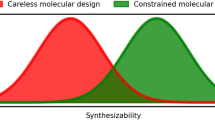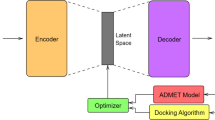Abstract
“Lead molecule” is a chemical compound deemed as a good candidate for drug discovery. Designing a lead molecule for optimization involves a complex phase in which researchers look for compounds that satisfy pharmaceutical properties and can then be investigated for drug development and clinical trials. Finding the optimal lead molecule is a hard problem that commonly requires searching in high dimensional and large experimental spaces. In this paper we propose to discover the optimal lead molecule by developing an evolutionary model-based approach where different classes of statistical models can achieve relevant information. The analysis is conducted comparing two different chemical representations of molecules: the amino-boronic acid representation and the chemical fragment representation. To deal with the high dimensionality of the fragment representation we adopt the Formal Concept Analysis and we then derive the evolutionary path on a reduced number of fragments. This approach has been tested on a particular data set of 2500 molecules and the achieved results show the very good performance of this strategy.
Access this chapter
Tax calculation will be finalised at checkout
Purchases are for personal use only
Similar content being viewed by others
References
Pickett, S.D., Green, D.V.S., Hunt, D.L., Pardoe, D.A., Hughes, I.: Automated lead optimization of MMP-12 inhibitors using a genetic algorithm. ACS Med. Chem. Lett. 2(1), 28–33 (2011)
Devi, R.V., Siva, S.S., Coumar, M.S.: Evolutionary algorithms for de novo drug design - a survey. Appl. Soft Comput. 27, 543–552 (2015)
Baragona, R., Battaglia, F., Poli, I.: Evolutionary Statistical Procedures: An Evolutionary Computation Approach to Statistical Procedures Designs and Applications. Springer, Heidelberg (2013)
Borrotti, M., De March, D., Slanzi, D., Poli, I.: Designing lead optimization of MMP-12 inhibitors. Comput. Math. Methods Med. 1–8 (2014)
Slanzi, D., De Lucrezia, D., Poli, I.: Querying Bayesian networks to design experiments with application to 1AGY serine esterase protein engineering. Chemom. Intell. Lab. Syst. 149, 28–38 (2015)
Wille, R.: Restructuring lattice theory: an approach based on hierarchies of concepts. In: Rival, I. (ed.) Ordered Sets. NATO Advanced Study Institutes Series, vol. 83, pp. 445–470. Springer, Dortchet (1982)
Kaytoue-Uberall, M., Duplessis, S., Napoli, A.: Using formal concept analysis for the extraction of groups of co-expressed genes. In: Le Thi, H.A., Bouvry, P., Pham Dinh, T. (eds.) MCO 2008. CCIS, vol. 14, pp. 439–449. Springer, Heidelberg (2008). doi:10.1007/978-3-540-87477-5_47
Lounkine, E., Auer, J., Bajorath, J.: Formal concept analysis for the identification of molecular fragment combinations specific for active and highly potent compounds. J. Med. Chem. 17(51), 5342–5348 (2008)
Raza, K.: Formal concept analysis for knowledge discovery from biological data. arXiv preprint arXiv:1506.00366 (2015)
Tibshirani, R.: Regression shrinkage and selection via the lasso. J. R. Stat. Soc. Ser. B Stat. Methodol. 58(1), 267–288 (1996)
Hastie, T.J., Tibshirani, R.J., Friedman, J.H.: The Elements of Statistical Learning: Data Mining, Inference, and Prediction. Springer Series in Statistics. Springer, New York (2009)
Bühlmann, P.: Boosting for high-dimensional linear models. Ann. Stat. 34(2), 559–583 (2006)
Acknowledgements
The authors would like to acknowledge Professor Philip J. Brown and the GlaxoSmithKline Medicines Research Centre (UK) for the very fruitful collaboration in developing this research.
Author information
Authors and Affiliations
Corresponding author
Editor information
Editors and Affiliations
Rights and permissions
Copyright information
© 2017 Springer International Publishing AG
About this paper
Cite this paper
Giovannelli, A., Slanzi, D., Khoroshiltseva, M., Poli, I. (2017). Model-Based Lead Molecule Design. In: Rossi, F., Piotto, S., Concilio, S. (eds) Advances in Artificial Life, Evolutionary Computation, and Systems Chemistry. WIVACE 2016. Communications in Computer and Information Science, vol 708. Springer, Cham. https://doi.org/10.1007/978-3-319-57711-1_9
Download citation
DOI: https://doi.org/10.1007/978-3-319-57711-1_9
Published:
Publisher Name: Springer, Cham
Print ISBN: 978-3-319-57710-4
Online ISBN: 978-3-319-57711-1
eBook Packages: Computer ScienceComputer Science (R0)




